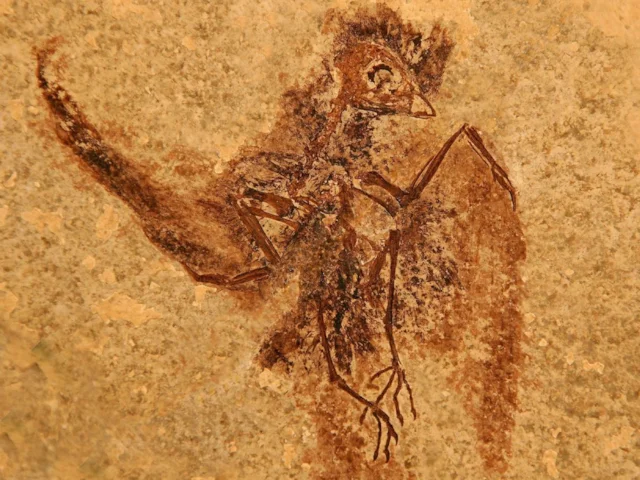New fossil illuminates swift evolution
de1412ce-7684-4bb9-af1a-de5054349522

An almost complete feathered fossil of a bird intermediate between hummingbirds and swifts has shined a light on the early evolution of the two families.
A bird fossil from a rich ancient assemblage in rocks known as the Green River Formation in Wyoming, USA, has given insight into the evolution of swifts and hummingbirds, which are grouped together in the order Apodiformes. The newly-evaluated specimen, uncovered at the field Museum in Chicago, has a great deal of tell-tale skeletal and feather detail on it and dates from around 52 million years ago, from rocks that have previously yielded an ancestral frigatebird and roller.
Though seemingly highly evolved, swifts (with their long curved wings, adapted for high speed, and short wide beaks) and hummingbirds (with short blade-like wings for hovering and long, curved bills for nectar-sucking) share many physical features that betray their ancestral closeness. The new fossil – Eocypselus rowei – is closer to swifts in wing-shape, but is placed basally to the whole lineage by skeletal features. It has a short, rounded beak unlike most of its descendants.
Individual feathers can be clearly assessed from the specimen. It appears to have had a tree swift-like crest of some sort (assuming that feathers have not been splayed in the preservation process), and the flight feathers are long and somewhat curved, similar to modern true swifts; the tail is short and square, perhaps like Little Swift. Minute preservation of pigment cells associated with the feathers indicate that it would have been black or black with some iridescence, again like modern true swifts.
Due to the fact that E rowei is not a true swift but shared much of that family's morphology so early on, it can be viewed as being ancestral; the wing shape still has intermediate but perhaps less specialised characters placing the species between swifts and hummingbirds. The feet appear to be adapted to perching, unlike modern swifts, and it is likely that the more vestigial legs of modern swifts arose specifically in that lineage, as stem hummingbirds have been found with long legs.
E rowei is the closest fossil yet to the point where swifts and hummingbirds diverged, and it is interesting to speculate what the species may have eaten and how it may have lived; superficially at least it looks as if it may have filled a swallow-like niche, eating insects on the wing but also perching and landing on occasion. As our own Common Swifts arrive en masse during the next week or so, it is perhaps somewhat mind-blowing that one could have very similar birds shooting around the skies over 50 million years ago.
Reference
Ksepka, D T, Clarke, J A, Nesbitt, S J, Kulp, F B, and Grande, L. 2013. Fossil evidence of wing shape in a stem relative of sifts and hummingbirds (Aves, Pan-Apodiformes). Proceedings of the Royal Society B 280: 20130580 http://dx.doi.org/10.1098/rspb.2013.0580
A bird fossil from a rich ancient assemblage in rocks known as the Green River Formation in Wyoming, USA, has given insight into the evolution of swifts and hummingbirds, which are grouped together in the order Apodiformes. The newly-evaluated specimen, uncovered at the field Museum in Chicago, has a great deal of tell-tale skeletal and feather detail on it and dates from around 52 million years ago, from rocks that have previously yielded an ancestral frigatebird and roller.
Though seemingly highly evolved, swifts (with their long curved wings, adapted for high speed, and short wide beaks) and hummingbirds (with short blade-like wings for hovering and long, curved bills for nectar-sucking) share many physical features that betray their ancestral closeness. The new fossil – Eocypselus rowei – is closer to swifts in wing-shape, but is placed basally to the whole lineage by skeletal features. It has a short, rounded beak unlike most of its descendants.
Individual feathers can be clearly assessed from the specimen. It appears to have had a tree swift-like crest of some sort (assuming that feathers have not been splayed in the preservation process), and the flight feathers are long and somewhat curved, similar to modern true swifts; the tail is short and square, perhaps like Little Swift. Minute preservation of pigment cells associated with the feathers indicate that it would have been black or black with some iridescence, again like modern true swifts.
Due to the fact that E rowei is not a true swift but shared much of that family's morphology so early on, it can be viewed as being ancestral; the wing shape still has intermediate but perhaps less specialised characters placing the species between swifts and hummingbirds. The feet appear to be adapted to perching, unlike modern swifts, and it is likely that the more vestigial legs of modern swifts arose specifically in that lineage, as stem hummingbirds have been found with long legs.
E rowei is the closest fossil yet to the point where swifts and hummingbirds diverged, and it is interesting to speculate what the species may have eaten and how it may have lived; superficially at least it looks as if it may have filled a swallow-like niche, eating insects on the wing but also perching and landing on occasion. As our own Common Swifts arrive en masse during the next week or so, it is perhaps somewhat mind-blowing that one could have very similar birds shooting around the skies over 50 million years ago.
Reference
Ksepka, D T, Clarke, J A, Nesbitt, S J, Kulp, F B, and Grande, L. 2013. Fossil evidence of wing shape in a stem relative of sifts and hummingbirds (Aves, Pan-Apodiformes). Proceedings of the Royal Society B 280: 20130580 http://dx.doi.org/10.1098/rspb.2013.0580

